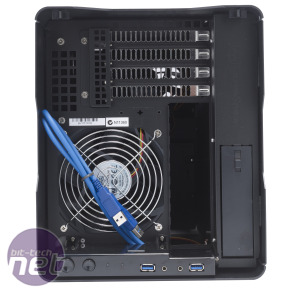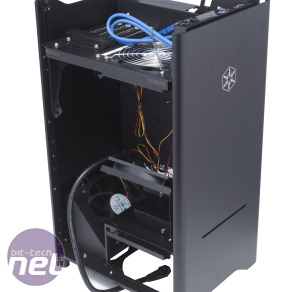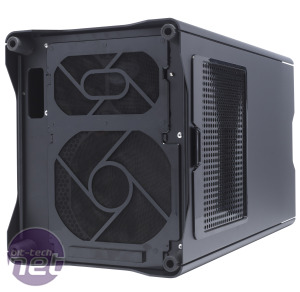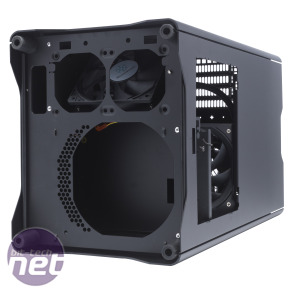
SilverStone FT03 Interior
Peeling off one of the pleasingly solid side panels is a breeze - they slot into the case on rails, meaning there’s no need to reach for your screwdriver to get inside your PC. The front panel is also removable and secured by four clips, requiring an almost disconcertingly firm tug to pull it free.Once the side and front panels are removed, you’ll probably want to step back for a minute and just take a good hard look at the innards of the case. This isn't like any PC case you’ve ever seen before. For a start, the case adheres to the inverted design that we’ve seen before in other SilverStone cases, such as the Raven RV02 and the Fortress FT02. This means that cool air is drawn into the base of the case and exhausted from the roof, rather than being dragged from front to back.
This method of cooling has the benefit of being logical - hot air rises after all - but it’s not foolproof, as we saw with the original Raven RV01; you still need a fair amount of airflow to carry the heat out of the case. In the FT03 this airflow is provided by two 120mm intake fans located towards the bottom of the case, one of which draws in air through a dust filter-equipped vent in the base of the case. The other fan pulls in air through the removable side vent mentioned earlier. These fans are angled towards the graphics card and the CPU cooler respectively.
Clearly SilverStone has done well to cram two 120mm intake fans into such a small case, although it’s worth noting that the angles at which the fans are positioned could affect their effectiveness - air generally likes to travel in straight lines.
Joining the intake fans in the base of the case is the PSU, which has its own dedicated intake and exhaust vents, meaning that its waste heat is effectively isolated from the rest of the PC. To enable this thermally beneficial arrangement, SilverStone has had to seat the PSU flat against the base of the case, which means there’s very little wiggle-room around the PSU, and no room for a power lead to be plugged into the socket. SilverStone has got around this by placing the power socket for the PSU in the base of the case, with an extension cable sporting a low-profile plug running from this to the PSU.
We were initially puzzled about where we were meant to locate our hard disk, but a quick glance at the instruction manual revealed the two hard disk caddies to be slyly located behind the motherboard tray. This is an excellent bit of space-saving design, and there’s even a 2.5in SSD mount here too.
It’s also worth nothing that there is actually a third hard disk mount located behind the motherboard tray, but this one takes the shape of a hot swappable caddy that can be accessed from the top of the case. This is a neat little touch, especially in a case in which space is at a premium. The only problem is that not many people regularly hot-swap full sized hard disks these days, so the hot-swap ability of this bay will be ignored by most people.
Building a system inside the FT03 is challenging, but not to the point of exasperation. You have to pay more attention to cable routeing and tidying in a smaller case, but there’s ample room for stashing extra PSU cables behind the motherboard tray and the motherboard tray cut-outs are perfectly placed for power cable routeing.
Having said this, we were only running our system with a single hard disk, so we were able to use the spare hard disk bay for stashing cables. If you’re planning to use both of the hard disk bays, you’ll have much less room to hide your PSU cables.

MSI MPG Velox 100R Chassis Review
October 14 2021 | 15:04












Want to comment? Please log in.